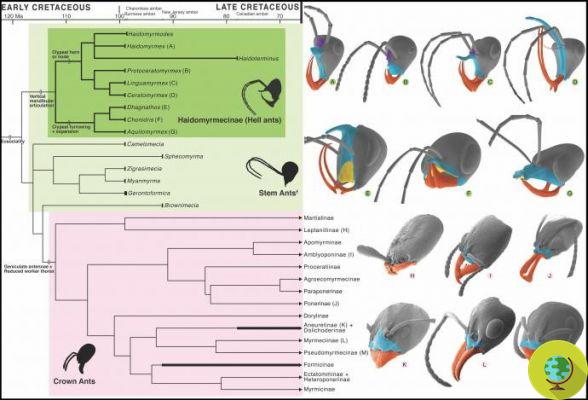Attack gone bad: 100-million-year-old hell ant attempts to catch insect but both get trapped in amber
Attack gone bad: a 100 million year old ant tries to catch an insect but they are both trapped in amber and so they have come down to us. The incredible "fossil scene" was unearthed and analyzed by a research team from the New Jersey Institute of Technology (NJIT), the Chinese Academy of Sciences and the University of Rennes in France.
It has been defined as a "hell ant" but hell has overwhelmed it too: researchers have found an extraordinary fossil of about 100 million years that preserves intact an enigmatic predatory insect from the Cretaceous period, called the infernal ant due to its particular aggressiveness, while tries to capture his unsuspecting victim of the moment, a relative of the cockroach known as Caputoraptor elegans, also extinct.
But everything went wrong also to the "executioner" as well as to the victim because both were trapped in amber. The scene that has remained immortalized - it must be said - offers a detailed look at a recently identified prehistoric ant species (Ceratomyrmex ellenbergeri), and shows some of the earliest direct evidence of their killer characteristics, first and foremost the use of bizarre and deadly sickle-like jaws in a vertical motion that nails the prey.
Evolution then led the ants to select less aggressive individuals. In particular, predatory traits are supposed to have vanished along with many other early groups of ants over the course of theCretaceous-Paleogene mass extinction occurred about 65 million years and considered one of the major faunal extinctions, which led to disappearance of about 70% of existing marine and continental species.
"Fossilized behavior is extremely rare, especially predation - explains Phillip Barden, lead author of the work - As paleontologists, we hypothesize the function of ancient adaptations using the available evidence, but an extinct predator caught in the act of capturing its prey is a find of inestimable value".
The scene particularly confirms the theories about the mouthparts of the infernal ants, able to move up and down in a different direction from that of all living ants and almost all insects.
"Since the first infernal ant was unearthed about a hundred years ago, it has remained a mystery why these extinct animals are so different from the ants we have today - adds Barden - This fossil reveals the mechanism behind what we could. to call it an "evolutionary experiment" and, although we see numerous examples in the fossil record, we often do not have a clear picture of this path. "
The team also conducted aphylogenetic analysis to reconstruct the evolutionary relationships between the ants of the Cretaceous and the modern ones: the analyzes have confirmed that the infernal ants belong to one of the first branches of the evolutionary tree and that these are the closest relatives to each other.

©New Jersey Institute of Technology/Chinese Academy of Sciences/University of Rennes
It also appears that the relationship between the jaw and the morphology of the head is unique in infernal ants compared to living species due to their specialized prey-catching behavior. Which in modern ones has disappeared.
It is not yet clear, however, why these ants are extinct to the benefit of much less aggressive species. But it certainly indicates how even omnipresent animals can succumb.
“I think fossil insects remind us that even something as ubiquitous and familiar as ants can go extinct,” concludes Barden.
And it is good understand how and why.
The work was published in Current Biology.
Sources of reference: New Jersey Institute of Technology / Current Biology
Read also:
- Fossil of this ancient marine creature found in the resin of a tree
- A 66 million-year-old fossil found among stones thrown during protests in Chile


























